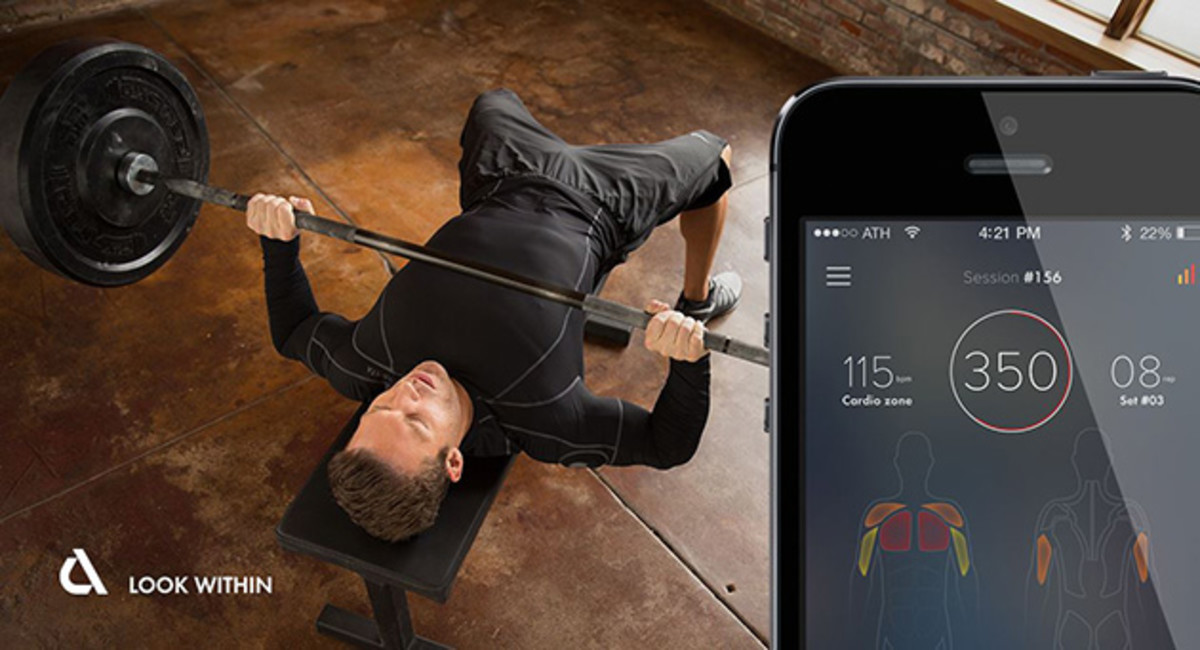Athos high-tech biometric clothing offers wearable fitness tracking

Among other weird and wonderful creations, TV infomercials and dubious websites are full of devices that promise to get you toned by electrocution—running an electrical current through your muscles while you sit back and “relax.” Athos, a new brand of biometric fitness clothing, is taking a different approach: you do the work, but they’ll tell you exactly how and when you engaged each muscle. And, with Athos, there’s no risk of electric shock.
The company’s shorts and shirts incorporate sensors that measure muscle activity through electromyography (EMG). As the nerves at the center of a muscle fire to tell it to contract, electrical signals pass outwards through the muscle body. By measuring the strength and speed of these signals on the skin’s surface, the amount of engagement and reaction time of the muscle can be determined.
The old way to do this was by sticking electrodes to the skin and running wires out to a computer, which made exercising while using EMG a little difficult. “Up until us, really, all of this technology has been exclusively used in high-performance institutes,” says Julie Desjardins, head of research at Athos, “places where professional athletes would go to train, a lot of rehab clinics—sports rehabilitation, physical rehabilitation—and in neuromuscular disorder research.”
USWNT players adopting protective headgear for the Women's World Cup
Instead of stick-on electrodes, Athos uses three parallel conductive rubber strips located on one side of the center of each muscle. The strips are held in place against the skin by the compression of the clothing. For each muscle, the innermost and outermost strips are used to measure the strength and speed of the electrical signal induced, and the central strips of each sensor are connected together as a sort of “ground” that allows ambient signals, such as from lights or televisions, to be identified and filtered out. Instead of using wires, the readings from these sensors are transmitted through conductive material to a pebble-sized transmitter. This transmitter, or “core” in Athos terminology, fits into a pouch on the right hip (shorts/capris) or in the center of the chest (shirt).
By integrating the sensors into clothing, Athos is trying to make the experience of using EMG as natural as possible. “You have to wear clothes to the gym,” Desjardins says, “so it’s not like we’re suddenly asking you to put on something else you wouldn’t normally wear.”
That synthesis of fabric and technology isn’t perfect, though. Some parts of the clothing are a little inflexible, and some of the material used is not breathable. But the data is worth any slight discomfort. The Athos iOS app displays a live color-coded effort level for each muscle during an exercise, and creates a post-exercise summary that shows the average effort, left-right balance, and order in which muscles were engaged. And that real-time biofeedback is addictive. “When you stop, and those lights go out,” Desjardins says, “there’s this intense internal desire to get them to come back on.”

According to Desjardins, one of the advantages of using Athos’s gear is that it can exactly monitor how much effort each muscle has exerted during a training session, and perhaps increase exercise efficiency in the gym. “Right now there’s kind of a clock-punching mentality where you go in and you punch in your card and you stay there for an hour and you punch out,” she says. “Well it turns out you may not need that hour. … You really can do the same thing in half an hour, just by doing it efficiently.”
But this is about far more than time management. Knowing how and when each muscle engages can help fix imbalances or incorrect exercise form, and thus prevent injury or speed up rehabilitation. Physical therapists could even send patients away wearing Athos clothing and then check up on whether they did their rehab homework correctly. Athos has also managed to measure a person’s full electrocardiogram from electrical signals on the lower body, though current versions of the app don’t include this feature. On a purely technological level, extracting the full variation of the heart muscle from electrical traces more than a foot away is an impressive feat of signal processing.
Athos is not the only company using EMG for fitness applications. Myontech, based in Finland, sells shorts that use a fabric sensor to detect muscle activity. However, these shorts only detect muscle effort on the front and back of the leg, whereas Athos targets four muscles on the lower body, and seven on the upper body.
The Athos core retails online for $199, and the shirts, shorts, or women’s capris cost $99 each. Both the core and the shorts/capris are currently available, but the shirts, which are still under development, are due to ship this summer.
Teams from all of the big four major leagues as well as soccer and cycling have shown an interest in what Athos is doing, but perhaps the first professional sport to adopt this technology could be basketball. One of Athos’s investors is Joe Jacob, majority owner of the Golden State Warriors, and, according to Desjardins, the company is already working on a prototype version for the Warriors’ D-League team in Santa Cruz.
